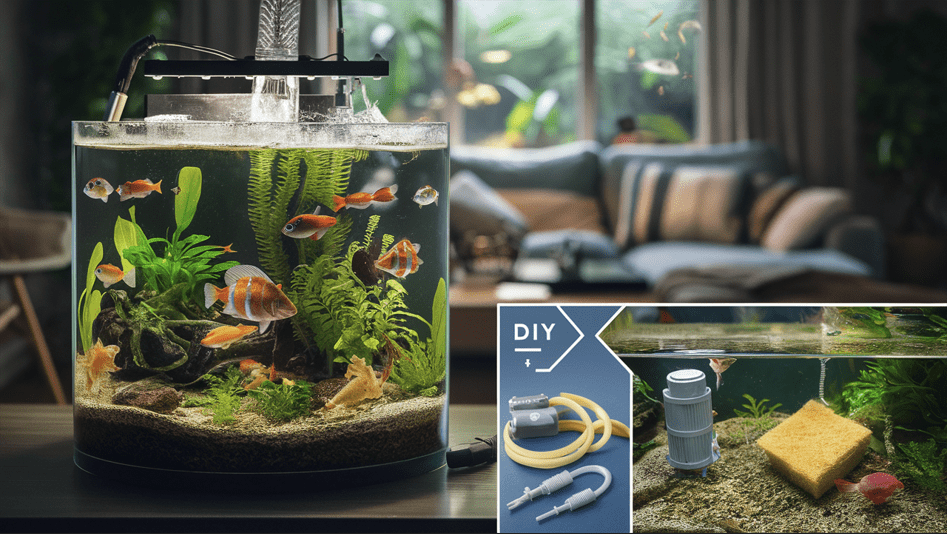Table of Contents
Imagine you’ve just set up a gorgeous new aquarium in your living room, teeming with vibrant fish and lush underwater plants. Everything seems perfect until you notice the water getting murky. What’s next? Many aquarium enthusiasts face this moment, leading them to explore filtration options. Store-bought filters can be both costly and confusing, but don’t fret! Building a homemade aquarium filter is simpler and more effective than you might think. In this guide, we’ll walk you through how to create a reliable filter for your aquarium, ensuring a clean, healthy environment for your aquatic friends.
Why Consider a Homemade Aquarium Filter?
Before diving into the “how,” let’s explore the “why.” Why would building your own filter be a smart idea?
- Cost-Effective: Purchased filters can be pricey, especially those for larger tanks. Homemade options often utilize materials you already have at home.
- Customizable: You have complete control over the design, allowing you to create a filter that meets your specific needs and preferences.
- Eco-Friendly: Building a filter from scratch can reduce waste and promote recycling, which is a big plus for environmentally conscious aquarium owners.
Materials You’ll Need
To start, gather the following materials and tools:
- A plastic bottle (1-2 liters)
- Aquarium air pump and airline tubing
- Filter media (sponge, coarse gravel, and activated charcoal)
- Scissors or a craft knife
- Aquarium-safe silicone sealant
- Airstone (optional)
Note: Ensure all materials are clean and safe for aquarium use. Avoid containers that previously held chemicals or toxic substances.
Step-by-Step Guide to Building the Filter
Preparing the Filter Housing
First, let’s prepare the plastic bottle, which will serve as the housing for your filter materials.
- Choose the Right Bottle:
- Pick a plastic bottle based on your aquarium size. A 1-liter bottle works well for small tanks, while a 2-liter bottle is better suited for larger setups.
- Cut the Bottle:
- Use scissors or a craft knife to carefully cut the bottle horizontally into two or three sections. The base will hold the filter media, and the upper part will contain the outflow system.
- Smooth the edges with sandpaper to avoid sharp bits that could harm your fish.
Adding the Filter Media
The secret to an effective filter is the right blend of media to trap debris and promote beneficial bacteria growth.
- Layer the Sponge:
- Cut a piece of sponge to fit snugly at the bottom of the bottle. This will be your first layer and catch larger particles.
- Add Coarse Gravel:
- Add a layer of coarse gravel on top of the sponge. This layer helps in mechanical filtration by trapping smaller particles.
- Include Activated Charcoal:
- Pour a layer of activated charcoal above the gravel. Charcoal helps in chemical filtration, removing toxins and odors from the water.
- Seal with Another Sponge Layer:
- Place another piece of sponge at the top to keep the charcoal in place and filter fine particles.
Setting Up the Air Pump
Now, let’s incorporate the air pump to ensure water circulation through the filter media.
- Drill Holes:
- Drill small holes around the neck of the bottle cap to allow water to flow freely.
- Attach Airline Tubing:
- Fit the airline tubing through the drilled holes, ensuring it reaches the bottom layer of the filter media.
- Add the Airstone (Optional):
- Attach an airstone to the end of the airline tubing to disperse the air bubbles more evenly.
Assembling the Filter
- Combine the Sections:
- Reassemble the bottle sections, ensuring all layers of media are intact. Use aquarium-safe silicone sealant to secure the pieces and prevent leaks.
- Connect the Air Pump:
- Attach the other end of the airline tubing to the aquarium air pump and place the assembled filter inside the tank.
Ensuring Your Filter Works Efficiently
To keep your DIY filter in optimal condition:
- Regular Maintenance:
- Rinse the sponge and gravel with dechlorinated water weekly to prevent clogging.
- Monitor Water Quality:
- Test your aquarium water regularly to ensure the filter effectively maintains the optimal conditions for your fish.
- Adjust Air Flow:
- If needed, adjust the air pump setting to ensure efficient but gentle water flow through the filter media.
Conclusion
Building a homemade aquarium filter is not only rewarding but also incredibly practical. With a few simple materials and a bit of effort, you can create a custom filtration system that keeps your tank clean and healthy. Plus, the satisfaction of crafting something beneficial for your aquatic pets adds an extra layer of joy to your fish-keeping hobby.
Now that you’re armed with this knowledge, why not try it for yourself? Experiment with different filter media combinations and see what works best for your aquarium setup. Your fish will thank you for the crystal-clear waters they get to swim in!
Call to Action: Have you tried building a homemade aquarium filter before? Share your experiences or tips in the comments below! And don’t forget to subscribe for more DIY aquarium projects and tips.
For more insights on aquarium care or related topics, feel free to check out this guide on maintaining a healthy fish tank.
